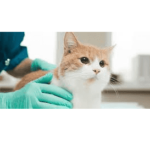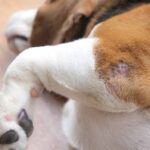
An abscess forms when an infected bite wound heals over on its surface and seals the infection inside. Fever often accompanies this the infection incubates. The diseased tissue turns into pus. In many cases pus bursts through the overlying surface skin and drains, leading to foul odor, pain, and discharge. Most abscesses require veterinary attention to resolve.
What to Look for at Home
If the abscess has not yet ruptured, the cat will most likely be feverish, which means you will see listlessness and appetite loss. Depending on how long the area has been swollen, the skin involved may be very tender or fragile.
The fluid pocket will eventually rupture and release foul-smelling pus. You may not see the sore but you probably will smell it.
Some cats will lick the fur away from the wound, making the area more visible. At this point, it is likely to look raw and may no longer be actively draining pus. Sometimes the overlying skin is especially fragile and simply tears away leaving a large raw area.
Sometimes the wound is buried in the fur so deeply that it is not apparent. You may only find a tender area and possibly notice the odor characteristic of deep infection.
Common areas for bite wound abscesses include the facial cheeks, the legs, and the base of the tail. These are the areas where fighting cats tend to bite one another. A fleeing cat is likely to have a bite on the rear part of its body. A brawling cat is more likely to have one on its face or neck.
If the abscess has not ruptured, your veterinarian will need to be lance it. Once the abscess is open, it will need to be flushed clean of infected debris. If the abscess is large or especially painful, sedation may be required to accomplish this.
Treatment
- Older abscesses may have enough devitalized overlying tissue to require surgical trimming and stitches. Some abscesses are large enough to require an indwelling rubber drain to assist with removal of the pus. You may have to flush the drain with disinfectant at home.
- The cat will likely need antibiotics at home. If so, you will need to give either pills or liquid medication (tell your veterinarian if you have a preference). Alternatively, there is an injectable antibiotic (Convenia®) that lasts two weeks that may be given in the clinic, eliminating the need for oral medication at home. This can be very helpful for outdoor cats that are hard to get on a regular antibiotic dosing schedule. Your veterinarian will likely recommend one of these treatments in addition to cleaning and flushing out the wound.
- Warm compresses are helpful for the first few days following discharge. The heat helps liquefy diseased tissues so that they can drain. To hot pack the area, use a warm (not hot) washcloth applied to the wound for 5 to 10 minutes once or twice a day as directed by your pet’s doctor.
Diseases Transmitted by Bites
Feline leukemia (FeLV) and feline immunodeficiency (FIV) viruses represent serious contagious infections spread by bite wounds. The American Association of Feline Practitioners has guidelines for viral testing.
Testing, can be easily done by an in-house test that most veterinarians keep in the practice. This test should ideally be done 60 days or more from the time of the bite. Indoor/Outdoor cats should be tested annually for these viruses regardless of vaccination status. We recommend testing at the time of the abscess treatment if a test has not been performed in the last year.
If your cat has not been vaccinated for rabies, it is especially important to make sure this vaccine is current. Rabies is transmitted by bite wounds and since there is no effective treatment for either animals or humans, it is important to consider this simple prevention.
Be sure you understand how to give medication, perform hot packing, and manage rubber drains if your pet has them. Most abscesses heal over the course of a week, though larger abscesses can take longer. If your cat’s abscess is not healed in one week, be sure to notify your veterinarian.


